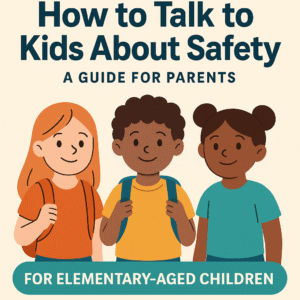How to Talk to Elementary Kids About Safety (Ages 6–10): Building Confidence and Rules
Elementary-aged children are naturally curious, eager to learn, and highly motivated by rules. They’re also beginning to spend more time away from their parents — walking to school, going on playdates, or exploring the neighborhood. This makes ages 6–10 a critical stage for expanding safety conversations.
At The Security Playbook, Coach Cover is here to guide parents through age-appropriate, trauma-informed strategies to help kids build confidence in handling real-world safety situations.
Why Safety Talks Are Essential at This Age
-
More independence = more exposure. Kids are walking to school, staying home with sitters, or riding bikes with friends.
-
They can follow rules. Unlike preschoolers, elementary kids can understand multi-step directions and see the “why” behind rules.
-
They’re rule-oriented. Framing safety as “family rules” helps them take it seriously.
Psychological Principles for Ages 6–10
-
Concrete thinkers: They understand consequences better but still prefer black-and-white rules.
-
Desire to please: Kids want approval from parents and teachers — use positive reinforcement.
-
Expanding social world: Friends, teachers, coaches, and online environments are part of daily life.
-
Fear of consequences: Be careful not to overwhelm; focus on empowerment.
Trauma-Informed Approach:
-
Avoid shame. Correct mistakes with encouragement, not fear.
-
Practice scenarios calmly and repeatedly.
-
Let them role-play both “good” and “bad” choices to learn.
Key Safety Topics for Ages 6–10
1. Walking & Traffic Safety
Elementary-aged kids are often walking to school, the park, or a friend’s house.
-
Teach them to use sidewalks, crosswalks, and traffic lights.
-
Drill: “Stop, Look, Listen, and Cross.”
Pro Tip: Practice the walk to school together several times before letting them go alone.
2. The Family “Safe Word”
Introduce a family password that only safe adults know.
-
If someone other than mom or dad picks them up, they must use the password.
-
If the adult doesn’t know it, kids know not to go with them.
Scenario: A stranger says, “Your mom sent me.” Your child asks for the safe word — they don’t know it. Your child walks away and alerts a teacher.
3. Stranger Awareness (with Nuance)
Kids this age can handle more nuance than preschoolers.
-
Teach: Not all strangers are bad, but never go anywhere with someone you don’t know.
-
If lost, look for another parent with kids or a uniformed employee.
4. Early Online Safety
Many kids get tablets or devices at this age.
-
Explain that the internet is like a “big neighborhood.”
-
Rule: Never share personal info (name, address, school).
-
Encourage them to come to you if they see anything confusing or scary.
5. Fire & Emergency Drills
-
Reinforce stop, drop, roll and how to crawl low under smoke.
-
Practice a family escape plan: two exits per room, meeting spot outside.
6. Safe Adults vs Unsafe Behavior
Teach that safe adults:
-
Don’t ask kids to keep secrets.
-
Don’t ask kids to break rules.
-
Don’t make them feel scared.
Role-play: Have your child practice saying, “I need to ask my mom first.”
7. Being Home Alone (Short Periods)
Some families start leaving 8–10-year-olds alone for short times.
-
Rule: Keep doors locked.
-
Don’t answer the door for strangers.
-
Call mom/dad if unsure.
Pro Tip: Practice “pretend” scenarios with them before actually leaving them alone.
How to Talk to Kids Ages 6–10 About Safety
-
Make it a Team Effort: Frame safety as something the family does together.
-
Practice Through Play: Role-play common scenarios — walking to school, answering a knock at the door, or using the safe word.
-
Use Checklists: Kids this age love lists they can check off. Create a family safety checklist for them.
Sample Conversation Starters
-
“What would you do if someone you don’t know asked you to get in their car?”
-
“Who are safe adults you can ask for help at school?”
-
“What’s our family safe word, and why do we use it?”
-
“If there was a fire, what’s the first thing you’d do?”
Common Mistakes Parents Make
❌ Using fear-based messaging (“Strangers will take you”).
❌ Assuming one conversation is enough. Repetition is key.
❌ Not practicing. Kids learn by doing, not just listening.
❌ Skipping online safety. Devices are a reality for many 6–10 year-olds.
FAQs for Parents of Kids Ages 6–10
Q: At what age can kids walk to school alone?
👉 Depends on maturity, distance, and community safety. Start with supervised practice.
Q: How do I keep them safe online without scaring them?
👉 Compare the internet to a big playground — some places are safe, others aren’t. Encourage them to always “check in” with you.
Q: My child pushes back on rules. How do I handle it?
👉 Emphasize family teamwork and that rules exist to protect, not punish. Involve them in creating the rules.
Wrapping It Up: Safety as Responsibility
At ages 6–10, kids are ready to handle more independence — but with independence comes responsibility. Teaching them clear rules, practicing safety routines, and reinforcing positive choices will build confidence and resilience.
These lessons should feel empowering, not overwhelming. With consistency, your child will carry these skills for life.
👉 Ready to take the next step? Walk through your home together and try our FREE Home Security Score Assessment to see how your family measures up.
Stay safe, stay proactive.
— Coach Cover & The Security Playbook

